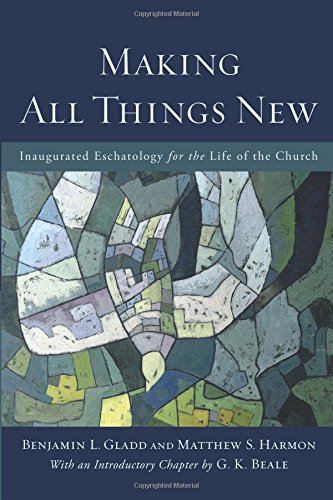A Brief Book Summary from Books at a Glance
About the Authors
Benjamin L. Gladd (PhD, Wheaton College) is assistant professor of New Testament at Reformed Theological Seminary in Jackson, Mississippi. Matthew S. Harmon (PhD, Wheaton College) is professor of New Testament studies at Grace College and Theological Seminary in Winona Lake, Indiana.
Table of Contents
Preface
Acknowledgments
Abbreviations
Part 1: Theological Foundation: Grasping the Already-Not Yet
1. The End Starts at the Beginning, G.K. Beale
2. The Nature of the End-Time Church
3. Life in the Overlap of the Ages
Part 2: Pastoral Leadership: Leading God’s End-Time Flock in the Already-Not Yet
4. Feeding the Flock
5. Guarding the Flock
6. Guiding the Flock
Part 3: End-Time Ministry: Service in the Latter-Day Temple of God
7. Worship: Celebrating the Inaugurated New Covenant
8. Prayer: Pleading for the Consummation of the New-Creational Kingdom
9. Missions: Extending God’s Eschatological Presence to the Ends of the Earth
Conclusion
Summary
Chapter One:
The End Starts at the Beginning, G.K. Beale
In this chapter, G.K. Beale lays the theological and exegetical foundation of inaugurated eschatology across the Scriptures. While systematicians have routinely placed all that the Bible has to say about the closing of history under the title “eschatology” or “last things,” Beale argues that “eschatology” actually bleeds into, if not entirely encompasses, every systematic category found in the New Testament—christology, ecclesiology, soteriology, etc. The New Testament authors understood themselves to be writing within the “last days,” and so speaking of the “last days” as something still in the future distorts the New Testament message at a fundamental level. The “last days” began following Christ’s resurrection, hence “inaugurated eschatology.”
Beale proceeds to defend this thesis and develop some of its hermeneutical implications. The New Testament language of the “last days” stands in clear relation to the Old Testament’s use and application of such language, and so Beale takes a look at Old Testament eschatological expectations. In broad strokes, Beale comments on Israel’s ultimate mission to “bless the earth” with “God’s salvific presence.” This commission originated in Adam, was lost by the same, and was then picked up by national Israel. In every case, the successful completion of this mission comes through “conquering land, multiplying population, and filling the earth with people who reflect God’s glory.” The Old Testament understanding of kingship is tied into this overall eschatological goal. This goal never changes though it proceeds through various cycles of success and failure.
In the midst of these cycles come the prophecies regarding the “latter days.” For Beale, this phrase signaled for the Old Testament prophets a future time period that permanently and radically “breaks with the preceding historical epoch.” It was understood by the prophets that the cycle of failure to achieve a world restored by God’s salvific presence will be reversed by a messianic king.
Transitioning now to the New Testament, Beale argues that the New Testament authors believed Christ’s work, trials, and final vindication through resurrection began the epoch of the “last days” prophesied in the Old Testament. Beale cites extensive textual evidence to support this claim. From this evidence, Beale draws at least three major conclusions. First, as the resurrection was understood in the Old Testament to be the beginning point of the “last days,” so Christ’s resurrection is the beginning point of the “last days” and the “new creation.” Second, the Old Testament and New Testament use of the term “latter days” is nearly identical with one exception: “in the New Testament the end days … are seen as beginning fulfillment with Christ’s first coming and culminating in a final consummated fulfillment at the very end of history.” Thirdly, the Old Testament language about what will happen in the “latter days”—i.e., conquest of land/earth, population increase, gentile inclusion, etc.—are now beginning to be fulfilled in Christ through the church because the church is “seen by the New Testament as the true Israel.”
Chapter Two:
The Nature of the End-Time Church
Beale’s chapter ended with a vision of the church fulfilling the Old Testament expectations of the restored people of God in the “last days.” This chapter picks up that theme and develops it more fully. To understand the church as the eschatological people of God, it must be…
[To continue reading this summary, please see below....]The remainder of this article is premium content. Become a member to continue reading.
Already have an account? Sign In
